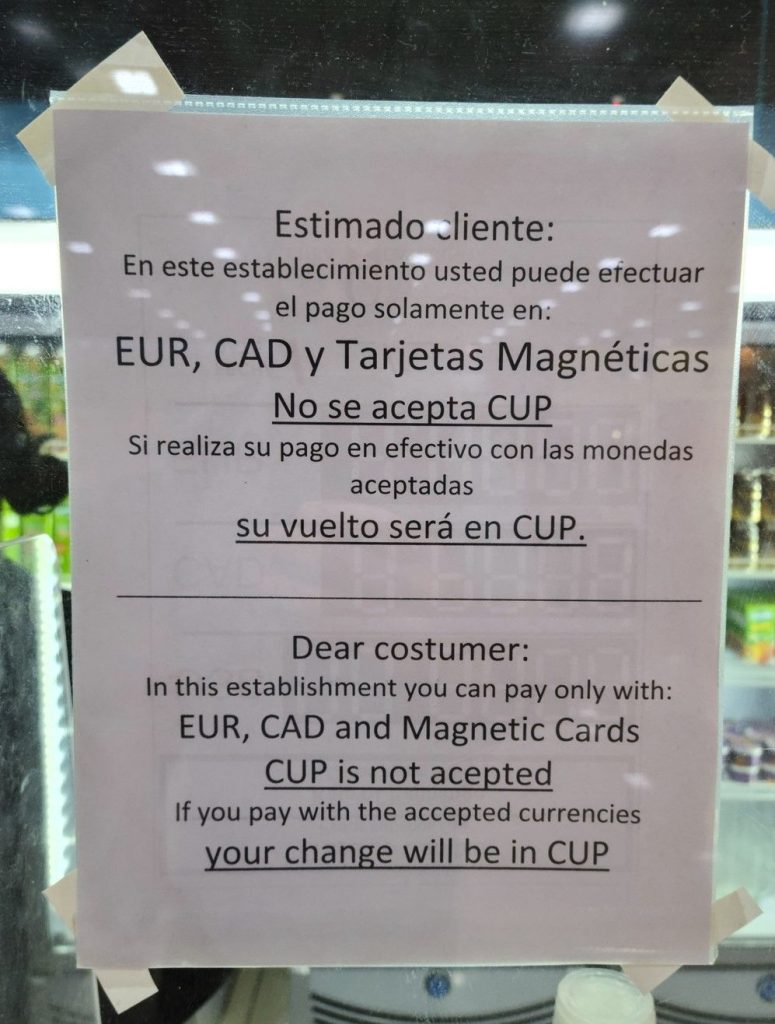Change on a Dime
May 3, 2022
Imagine getting paid in a currency you can’t use or having limitations on what you can buy. Unfortunately, many Cubans face this frustration daily. To experience what it’s like, put yourself in Ariel’s shoes and walk with me.
Another long work week ends, and Ariel gets paid in your country’s national currency – the Cuban peso (CUP). He heads home with money in his pocket and needs to buy some food for the weekend. Ariel walks to the nearby store, and their shelves are empty. When the food arrives, he must wait six to eight hours to get one pack of chicken, hopefully. If Ariel has a friend on the inside, he gets a tip letting him know when the store’s delivery truck will arrive.
Disappointed and without any food to feed himself or his family, he starts walking home. On the way, Ariel passes a store with shelves full of food and essentials – even hard to find cooking oil. The locals know the store as the MLC store. The MLC store only accepts a digital card (MLC card) you can get at the bank. So, Ariel walks to the bank to get the MLC card. He gives them his CUP, but they will not accept the CUP for the MLC card. They only accept euros on this card.
The bank teller says, “Sorry, you cannot use the CUP for the MLC card, you need to use a euro.”
Ariel replies, “Well, my cousin in Miami gave me $100 US dollars. Can I use this to put money on the MLC card?”
The bank teller says, “No, sorry.”
So, Ariel asks, “Can I use the $100 US dollars or my CUP to buy euros?”
The teller replies, “No, I’m sorry, we do not accept US dollars. You can only use euros if you want to put money on the MLC card.” Ironically, MLC is Spanish for moneda libremente convertible, which means currency freely convertible.
Frustrated, Ariel asks, “Where can I get a euro with my CUP and US dollars?”
The teller responds, “I’m sorry again, I can’t help you.”
Still trying to find a way to get the MLC card, he asks, “Can my cousin send me euros from Miami? Wait, I know the answer. No, the embargo prevents bank transactions from the United States. Never mind.”
Defeated, Ariel leaves the bank to walk home. He worked hard all week and has money in his pocket, yet he can’t buy the only food available for purchase.
This story describes a typical situation for someone living in Cuba. But keep in mind things can change on a dime (nope, not a dime), but they can change very fast. It’s very complicated, and it took several conversations for me to understand it. But at the end of a mission trip a couple of months ago, the sign said it all at the airport.

The US dollar lets you exchange currency and get what you need on the black market. So, if you need to get something at the MLC store, you can exchange US dollars and get the MLC card. But unfortunately, the MLC card doesn’t track how much money is left on the card. So, you must keep track of the amount yourself, or you might lose the money you worked so hard for.
While the US dollar isn’t accepted for exchange at any bank, it’s still in demand on the black market and has a place in the economy. Unfortunately, any currency exchange on the black market instantly dilutes the value for the person making the exchange so the middleman can profit.
A year ago, the MLC stores were called dollar stores, and the exchange at the bank was 24 CUP for one dollar. Fifteen months ago, Cuba had two currencies. In the last 18 months, they removed a currency, eliminated the ability to exchange a dollar, and changed the dollar store to the MLC store, which only accepted a currency not easily accessible to the Cuban people. Each impacted the daily lives of every Cuban citizen. It’s caused long food lines waiting for deliveries to arrive. Long food lines prevent people from working the hours needed to make more money and keep putting food on the table for their families.
To help, Atulado brings essential resources and items that can’t be found in Cuba. For the most desperate situations, such as the homebound elderly, Atulado provides funds to the local church to be a safety net as these situations arise.
A couple of weeks ago, on a mission trip to Cuba, I went through the process of getting the MLC card. First, I had to buy euros before I left the US. There was a cost in the exchange rate, which was normal and reasonable. At the bank at the airport in Havana, I paid 1,000 euros for the MLC card with 995 on it, which isn’t bad. Then, to my surprise, I discovered the MLC card had dollars on it. Since the euro is more valuable than the dollar, I lost $75 to the bank in Cuba.
-Wayne S.